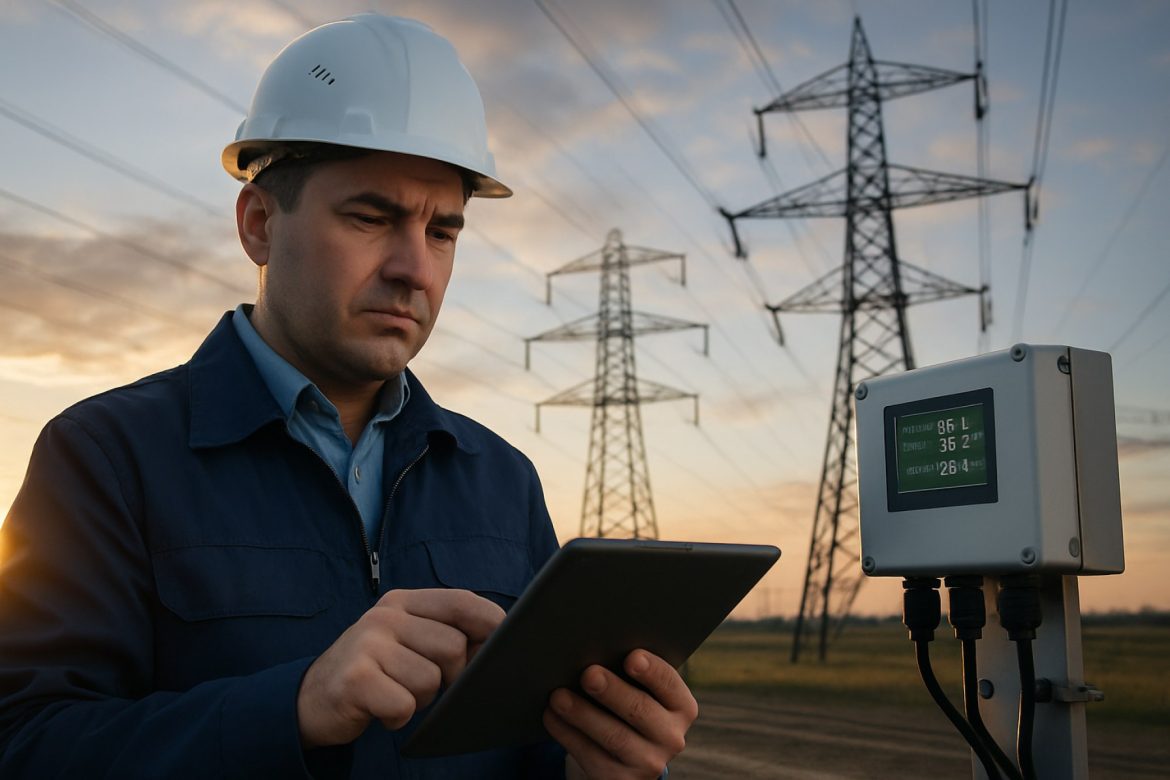Ampacity Monitoring Systems for High-Voltage Power Grids in 2025: Unlocking Real-Time Grid Optimization and Reliability. Discover How Next-Gen Sensing and Analytics Are Transforming Power Delivery Over the Next Five Years.
- Executive Summary: Market Drivers and Key Insights for 2025–2030
- Market Size, Growth Forecasts, and Competitive Landscape (2025–2030)
- Technology Overview: Core Components and Innovations in Ampacity Monitoring
- Regulatory Environment and Standards Impacting Adoption
- Key Applications: Utilities, Transmission Operators, and Industrial Users
- Regional Analysis: North America, Europe, Asia-Pacific, and Emerging Markets
- Vendor Profiles and Strategic Partnerships
- Challenges and Barriers to Widespread Implementation
- Future Outlook: Digitalization, AI Integration, and Grid Modernization Trends
- Conclusion and Strategic Recommendations
- Sources & References
Executive Summary: Market Drivers and Key Insights for 2025–2030
The global market for ampacity monitoring systems in high-voltage power grids is poised for significant growth between 2025 and 2030, driven by the increasing demand for grid reliability, integration of renewable energy sources, and the modernization of aging transmission infrastructure. Ampacity monitoring systems, which provide real-time data on the current-carrying capacity of power lines, are becoming essential tools for utilities seeking to optimize grid performance and prevent outages.
Key market drivers include the rapid expansion of renewable energy projects, which require dynamic management of transmission assets to accommodate variable generation. Utilities are under pressure to maximize the utilization of existing lines without compromising safety, making real-time ampacity monitoring a critical investment. Regulatory bodies in regions such as North America and Europe are also mandating stricter grid reliability standards, further accelerating adoption.
Technological advancements are enhancing the capabilities of ampacity monitoring systems. Innovations in sensor technology, data analytics, and cloud-based platforms are enabling more accurate and granular monitoring, as well as predictive maintenance. Companies such as Siemens Energy and Hitachi Energy are at the forefront, offering integrated solutions that combine hardware, software, and advanced analytics to deliver actionable insights for grid operators.
Another key insight is the growing emphasis on digitalization and automation within the power sector. Utilities are increasingly investing in digital grid solutions to enhance operational efficiency and resilience. Ampacity monitoring systems are being integrated with broader grid management platforms, enabling automated decision-making and faster response to changing grid conditions. Organizations like ABB and GE Grid Solutions are developing interoperable systems that support this trend.
Looking ahead to 2030, the market is expected to benefit from continued investments in smart grid infrastructure, particularly in emerging economies where electrification and grid expansion are priorities. The convergence of ampacity monitoring with other digital grid technologies will create new opportunities for innovation and value creation. As utilities strive to balance reliability, efficiency, and sustainability, ampacity monitoring systems will play a pivotal role in shaping the future of high-voltage power transmission.
Market Size, Growth Forecasts, and Competitive Landscape (2025–2030)
The global market for ampacity monitoring systems in high-voltage power grids is poised for significant expansion between 2025 and 2030, driven by the increasing integration of renewable energy sources, grid modernization initiatives, and the need for enhanced grid reliability. Ampacity monitoring systems, which provide real-time data on the current-carrying capacity of transmission lines, are becoming essential as utilities seek to optimize asset utilization and prevent thermal overloads.
According to industry projections, the market is expected to achieve a compound annual growth rate (CAGR) in the high single digits during this period. This growth is underpinned by regulatory mandates for grid resilience, the proliferation of distributed energy resources, and the rising incidence of extreme weather events that challenge grid stability. Utilities in North America and Europe are leading adopters, spurred by ambitious decarbonization targets and substantial investments in smart grid technologies. Meanwhile, emerging economies in Asia-Pacific are rapidly increasing their deployment of ampacity monitoring solutions to support expanding transmission infrastructure and urbanization.
The competitive landscape is characterized by a mix of established grid technology providers and innovative startups. Major players such as Siemens Energy, Hitachi Energy, and GE Grid Solutions offer comprehensive ampacity monitoring platforms integrated with advanced analytics and digital twin capabilities. These companies leverage their global presence and extensive R&D resources to deliver scalable, interoperable solutions tailored to utility requirements. In parallel, specialized firms like LumaSense Technologies (now part of AMETEK, Inc.) and OptaSense focus on fiber-optic and distributed sensing technologies, enabling high-resolution, real-time monitoring across vast transmission networks.
Strategic partnerships, mergers, and acquisitions are shaping the competitive dynamics, as companies seek to expand their technological capabilities and geographic reach. The market is also witnessing increased collaboration between utilities, technology vendors, and research institutions to develop next-generation ampacity monitoring solutions that incorporate artificial intelligence and machine learning for predictive maintenance and dynamic line rating.
Overall, the period from 2025 to 2030 is expected to see robust growth in the ampacity monitoring systems market, with innovation and digitalization at the forefront of competitive differentiation.
Technology Overview: Core Components and Innovations in Ampacity Monitoring
Ampacity monitoring systems are critical technologies deployed in high-voltage power grids to ensure the safe and efficient transmission of electricity. These systems continuously assess the real-time current-carrying capacity (ampacity) of transmission lines, factoring in dynamic environmental and operational conditions. The core components of modern ampacity monitoring systems include advanced sensors, data acquisition units, communication infrastructure, and analytics platforms.
At the heart of these systems are conductor-mounted sensors that measure key parameters such as line current, conductor temperature, ambient temperature, wind speed, and solar radiation. These sensors are often non-intrusive and designed to withstand harsh outdoor environments. For example, Siemens Energy and Hitachi Energy offer sensor solutions that provide high-precision, real-time data directly from transmission lines.
The data collected by these sensors is transmitted via robust communication networks, which may use wireless, fiber-optic, or satellite links to ensure reliable and secure data transfer to central control systems. GE Grid Solutions and ABB are among the companies providing communication infrastructure tailored for grid monitoring applications.
A key innovation in ampacity monitoring is the integration of advanced analytics and digital twin technologies. These platforms process real-time sensor data alongside weather forecasts and historical grid performance to calculate dynamic line ratings (DLR). This approach enables grid operators to maximize transmission capacity without compromising safety, especially during periods of fluctuating demand or adverse weather. Nexans and Lindsey Systems have developed solutions that leverage machine learning and predictive analytics to optimize grid performance.
Recent innovations also include the deployment of edge computing for local data processing, reducing latency and enabling faster decision-making. Additionally, the integration of ampacity monitoring with grid management software supports automated control actions, such as load redistribution or preventive maintenance scheduling.
In summary, the evolution of ampacity monitoring systems is driven by advancements in sensor technology, secure communications, and intelligent analytics, all of which are essential for the modernization and resilience of high-voltage power grids.
Regulatory Environment and Standards Impacting Adoption
The regulatory environment plays a pivotal role in the adoption and deployment of ampacity monitoring systems for high-voltage power grids. As grid operators seek to maximize transmission efficiency and reliability, real-time ampacity monitoring—measuring the maximum current-carrying capacity of conductors—has become increasingly important. Regulatory bodies and standards organizations are responding by updating frameworks to encourage or mandate the use of such technologies.
In the European Union, the European Union Agency for the Cooperation of Energy Regulators (ACER) and the European Network of Transmission System Operators for Electricity (ENTSO-E) have issued guidelines and network codes that emphasize dynamic line rating (DLR) and real-time monitoring to optimize grid utilization and support renewable integration. These frameworks encourage transmission system operators (TSOs) to implement advanced monitoring solutions, including ampacity monitoring, to meet grid reliability and decarbonization targets.
In the United States, the Federal Energy Regulatory Commission (FERC) has issued orders and guidance supporting the adoption of technologies that enhance grid flexibility and resilience. FERC Order No. 881, for example, requires transmission providers to implement ambient-adjusted ratings, which often necessitate real-time ampacity monitoring systems. The North American Electric Reliability Corporation (NERC) also sets reliability standards that increasingly reference the need for accurate, real-time data on transmission line conditions.
Globally, the International Electrotechnical Commission (IEC) has developed standards such as IEC 60287 and IEC 60853, which provide methodologies for calculating current ratings and thermal behavior of cables and overhead lines. These standards underpin the technical requirements for ampacity monitoring systems and are frequently referenced in national regulations and utility procurement specifications.
The evolving regulatory landscape is driving utilities and grid operators to invest in ampacity monitoring technologies to ensure compliance, improve asset utilization, and support the integration of variable renewable energy sources. As standards continue to evolve, interoperability and data security are also becoming focal points, with regulators and industry bodies emphasizing the need for secure, standardized data exchange protocols and robust cybersecurity measures.
Key Applications: Utilities, Transmission Operators, and Industrial Users
Ampacity monitoring systems are increasingly vital for high-voltage power grids, offering real-time insights into the current-carrying capacity of transmission lines. Their deployment is particularly significant for utilities, transmission system operators (TSOs), and industrial users, each of whom leverages these systems to address unique operational challenges and regulatory requirements.
For Électricité de France (EDF) and other utilities, ampacity monitoring enables dynamic line rating (DLR), allowing operators to maximize the use of existing infrastructure without compromising safety. By continuously assessing environmental conditions—such as temperature, wind speed, and solar radiation—utilities can safely increase transmission capacity during favorable conditions, thus deferring costly investments in new lines and improving grid reliability.
Transmission operators, such as Terna S.p.A. and National Grid, utilize ampacity monitoring to enhance situational awareness and grid flexibility. These systems support real-time decision-making for load management, congestion mitigation, and outage prevention. By integrating ampacity data into their energy management systems (EMS), TSOs can optimize power flows, reduce bottlenecks, and facilitate the integration of variable renewable energy sources, which is critical for meeting decarbonization targets.
Industrial users, particularly those with large-scale energy demands or private transmission assets—such as mining operations or chemical plants—benefit from ampacity monitoring by ensuring operational continuity and safety. For example, Siemens Energy provides solutions that help industrial clients monitor and manage the thermal limits of their internal grids, preventing equipment overheating and minimizing downtime. This is especially important in sectors where process interruptions can lead to significant financial losses or safety hazards.
Across all these applications, ampacity monitoring systems contribute to more efficient asset utilization, improved risk management, and enhanced compliance with regulatory standards. As grid modernization accelerates in 2025, the adoption of these systems is expected to expand, driven by the need for greater grid resilience, renewable integration, and cost-effective infrastructure management.
Regional Analysis: North America, Europe, Asia-Pacific, and Emerging Markets
Ampacity monitoring systems are increasingly vital for high-voltage power grids worldwide, enabling utilities to optimize transmission line capacity, enhance grid reliability, and integrate renewable energy sources. Regional adoption and market dynamics, however, vary significantly across North America, Europe, Asia-Pacific, and emerging markets.
North America leads in the deployment of advanced ampacity monitoring solutions, driven by aging grid infrastructure, regulatory mandates, and the need to accommodate distributed energy resources. Utilities in the United States and Canada are investing in real-time dynamic line rating (DLR) technologies to maximize existing transmission assets and defer costly upgrades. Organizations such as the North American Electric Reliability Corporation and Federal Energy Regulatory Commission support initiatives that encourage the adoption of grid-enhancing technologies, including ampacity monitoring.
Europe is characterized by a strong regulatory framework and ambitious decarbonization targets, which are accelerating the integration of ampacity monitoring systems. The European Union’s push for cross-border electricity trading and renewable integration has led transmission system operators (TSOs) to deploy DLR and related technologies. Entities like ENTSO-E and national grid operators are actively piloting and scaling ampacity monitoring to increase grid flexibility and resilience.
Asia-Pacific presents a diverse landscape. Developed markets such as Japan, South Korea, and Australia are early adopters, focusing on grid modernization and renewable integration. In China and India, rapid urbanization and industrialization are driving significant investments in high-voltage infrastructure, with growing interest in ampacity monitoring to address congestion and reliability challenges. Regional utilities and grid operators, including State Grid Corporation of China and Power Grid Corporation of India Limited, are exploring advanced monitoring solutions as part of broader smart grid initiatives.
Emerging markets in Latin America, Africa, and Southeast Asia are at earlier stages of adoption. Here, the focus is on expanding grid access and reliability, with ampacity monitoring systems gradually being introduced through pilot projects and international collaborations. Support from organizations such as the World Bank and regional development banks is crucial in facilitating technology transfer and capacity building.
Overall, while the pace and scale of ampacity monitoring system deployment differ by region, the global trend points toward increased adoption as utilities seek to optimize grid performance and support the energy transition.
Vendor Profiles and Strategic Partnerships
Ampacity monitoring systems are critical for optimizing the performance and safety of high-voltage power grids, enabling utilities to dynamically assess the current-carrying capacity of transmission lines in real time. The vendor landscape for these systems is characterized by a mix of established grid technology providers and innovative startups, each offering unique solutions that integrate advanced sensors, data analytics, and communication platforms.
Key industry players such as Siemens Energy and Hitachi Energy have developed comprehensive ampacity monitoring solutions that are often integrated into broader grid management platforms. These systems typically combine weather data, line temperature measurements, and real-time load information to provide dynamic line rating (DLR) capabilities, allowing operators to maximize transmission efficiency while maintaining safety margins.
Emerging vendors, including Luxcara and Smart Wires Inc., focus on modular, sensor-based monitoring devices that can be retrofitted onto existing infrastructure. Their solutions emphasize ease of deployment and interoperability with legacy systems, addressing the needs of utilities seeking to upgrade their monitoring capabilities without extensive capital investment.
Strategic partnerships are a defining feature of the ampacity monitoring ecosystem. Collaborations between technology vendors and transmission system operators (TSOs) are common, as seen in joint projects between ABB Ltd. and European grid operators to pilot DLR systems. Additionally, partnerships with meteorological data providers and IoT communication specialists, such as Vaisala Oyj, enhance the accuracy and reliability of ampacity forecasts by integrating high-resolution weather data and secure data transmission protocols.
Industry alliances, such as those fostered by the CIGRÉ (International Council on Large Electric Systems), play a pivotal role in standardizing ampacity monitoring practices and promoting interoperability among different vendors’ solutions. These collaborations facilitate knowledge sharing, accelerate technology adoption, and ensure that monitoring systems meet evolving regulatory and operational requirements.
In summary, the vendor landscape for ampacity monitoring systems is dynamic and collaborative, with strategic partnerships driving innovation and deployment. Utilities benefit from a diverse array of solutions tailored to both new and existing grid infrastructure, supported by a robust ecosystem of technology providers and industry organizations.
Challenges and Barriers to Widespread Implementation
The adoption of ampacity monitoring systems in high-voltage power grids faces several significant challenges and barriers, despite their potential to enhance grid reliability and optimize asset utilization. One of the primary obstacles is the integration of real-time monitoring technologies with existing grid infrastructure, much of which was not originally designed for advanced sensor deployment or digital communication. Retrofitting legacy systems can be costly and technically complex, requiring careful coordination to avoid service disruptions.
Another major challenge is the standardization of data protocols and interoperability between devices from different manufacturers. Without common standards, utilities may encounter difficulties in aggregating and analyzing data from diverse sources, limiting the effectiveness of ampacity monitoring. Organizations such as the Institute of Electrical and Electronics Engineers (IEEE) and CIGRÉ (International Council on Large Electric Systems) are working to address these issues, but widespread adoption of standards remains a work in progress.
Cybersecurity is also a growing concern as more grid components become connected and data-driven. Protecting sensitive operational data and ensuring the integrity of monitoring systems is critical, especially as cyber threats targeting energy infrastructure increase in sophistication. Utilities must invest in robust security measures and comply with evolving regulations, such as those set by the North American Electric Reliability Corporation (NERC).
Financial constraints present another barrier, particularly for smaller utilities or those operating in regions with limited budgets for capital improvements. The initial investment in sensors, communication networks, and data analytics platforms can be substantial, and the return on investment may not be immediately apparent. Demonstrating the long-term value of ampacity monitoring—such as reduced maintenance costs, deferred infrastructure upgrades, and improved outage management—remains a key challenge for technology providers and grid operators.
Finally, there is a need for specialized workforce training to manage and interpret the data generated by these systems. Utilities must develop new skill sets among their staff to fully leverage the benefits of real-time ampacity monitoring, which can be a slow and resource-intensive process.
Future Outlook: Digitalization, AI Integration, and Grid Modernization Trends
The future of ampacity monitoring systems for high-voltage power grids is being shaped by rapid digitalization, the integration of artificial intelligence (AI), and ongoing grid modernization efforts. As utilities worldwide confront the dual challenges of increasing electricity demand and the integration of variable renewable energy sources, real-time and predictive ampacity monitoring is becoming indispensable for optimizing grid performance and reliability.
Digitalization is enabling the deployment of advanced sensors, Internet of Things (IoT) devices, and cloud-based platforms that provide continuous, high-resolution data on conductor temperature, weather conditions, and line loading. These data streams are crucial for dynamic line rating (DLR) systems, which allow operators to maximize the use of existing transmission infrastructure without compromising safety. Companies such as Siemens Energy and Hitachi Energy are at the forefront, offering integrated solutions that combine hardware and software for comprehensive grid monitoring and control.
AI integration is set to revolutionize ampacity monitoring by enabling predictive analytics and automated decision-making. Machine learning algorithms can analyze historical and real-time data to forecast line capacity under varying environmental and operational conditions, supporting proactive grid management. This capability is particularly valuable for accommodating the fluctuating output of renewable energy sources and for preventing congestion or overheating. GE Grid Solutions and ABB Ltd are actively developing AI-driven platforms that enhance situational awareness and facilitate rapid response to grid events.
Grid modernization trends are also influencing the evolution of ampacity monitoring systems. The transition toward decentralized energy resources, electrification of transport, and the need for resilience against extreme weather events are driving investments in smarter, more flexible grid infrastructure. Regulatory bodies and industry organizations, such as the European Network of Transmission System Operators for Electricity (ENTSO-E), are promoting standards and best practices for the deployment of advanced monitoring technologies.
Looking ahead to 2025 and beyond, the convergence of digitalization, AI, and grid modernization will make ampacity monitoring systems more accurate, adaptive, and integral to grid operations. These advancements will not only improve asset utilization and reduce operational risks but also support the broader transition to a sustainable, resilient, and intelligent power grid.
Conclusion and Strategic Recommendations
Ampacity monitoring systems are increasingly vital for the reliable and efficient operation of high-voltage power grids. As the global energy landscape shifts toward higher renewable integration and greater demand variability, real-time monitoring of conductor ampacity enables grid operators to maximize asset utilization while maintaining safety margins. These systems leverage advanced sensors, data analytics, and communication technologies to provide dynamic line ratings, allowing for more flexible and resilient grid management.
Looking ahead to 2025, several strategic recommendations emerge for utilities and grid operators considering or expanding ampacity monitoring deployments:
- Prioritize Interoperability and Standardization: Select solutions that adhere to industry standards and can integrate seamlessly with existing SCADA and energy management systems. This ensures future scalability and compatibility with evolving grid architectures. Organizations such as CIGRÉ and IEEE provide valuable guidelines and standards for implementation.
- Invest in Cybersecurity: As ampacity monitoring systems become more interconnected, robust cybersecurity measures are essential to protect critical infrastructure from potential threats. Utilities should follow best practices outlined by bodies like National Institute of Standards and Technology (NIST) and European Union Agency for Cybersecurity (ENISA).
- Leverage Data Analytics and AI: Advanced analytics and artificial intelligence can enhance the value of ampacity data, enabling predictive maintenance, fault detection, and optimized grid operation. Collaborating with technology providers such as Siemens Energy and Hitachi Energy can accelerate digital transformation.
- Engage in Pilot Projects and Knowledge Sharing: Utilities should participate in pilot programs and share best practices through industry forums, such as those organized by ENTSO-E and Electric Power Research Institute (EPRI), to accelerate learning and adoption.
In conclusion, ampacity monitoring systems represent a strategic investment for grid modernization, enabling higher capacity utilization, improved reliability, and better integration of renewable resources. By focusing on interoperability, cybersecurity, advanced analytics, and industry collaboration, utilities can unlock the full potential of these technologies and future-proof their high-voltage networks.
Sources & References
- Siemens Energy
- Hitachi Energy
- GE Grid Solutions
- LumaSense Technologies
- AMETEK, Inc.
- OptaSense
- Nexans
- Lindsey Systems
- European Network of Transmission System Operators for Electricity (ENTSO-E)
- North American Electric Reliability Corporation (NERC)
- Terna S.p.A.
- National Grid
- Power Grid Corporation of India Limited
- World Bank
- Luxcara
- Smart Wires Inc.
- Vaisala Oyj
- CIGRÉ (International Council on Large Electric Systems)
- Institute of Electrical and Electronics Engineers (IEEE)
- National Institute of Standards and Technology (NIST)
- European Union Agency for Cybersecurity (ENISA)
- Electric Power Research Institute (EPRI)



